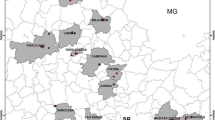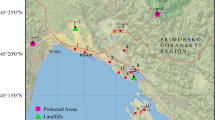Abstract
The growing population number and traffic loads, increasing environmental pressures, agricultural intensification, and the establishment of Mount Cameroon National Park demand farsighted environmental management in the region and the definition of a favorable ecological status. Since plants grow in the interface between soils and the atmosphere they can be used as passive biomonitors for the environmental quality. At the same time, the accumulation of nutrients and pollutants in crops is linked to human health, so that foliar elemental levels can be used as an integrative measure for environmental pollution and impact assessment. In the present study, we collected leaf samples of plantain, cassava, cocoyam, and maize on 28 sites at the southern flanks of Mt. Cameroon and determined 20 chemical elements. Air pollution in the study area comes from biomass and waste burning mainly, but emissions from traffic and a large refinery were believed to also play a significant role. However, spatial patterns in foliar elemental concentrations reflected the geochemistry rather than specific sources of pollution. Significant differences in foliar metal and nutrient levels were observed between the four species, indicating a different demand and uptake of specific elements. The results were compared to published data on nutrient concentrations in the tested species and the so-called reference plant. The data can be used as a baseline for future studies in plant nutrition and the environmental monitoring in inner tropical regions where these crops are grown.



Similar content being viewed by others
References
ACIAR (2013). Leafy green vegetables in the Tropics. Taro leaf. Australian Centre for International Agricultural Research. Available under: http://aciar.gov.au/files/node/15487/factsheets_2_pdf_68100.pdf accessed 15 August 2016.
Affum, H. A., Oduro-Afriyie, K., Nartey, V. K., Adomako, D., & Nyarko, B. J. (2008). Biomonitoring of airborne heavy metals along a major road in Accra, Ghana. Environmental Monitoring and Assessment, 137, 15–24.
Ako, A. A., Shimada, J., Hosono, T., Kagabu, M., Ayuk, A. R., Nkeng, G. E., Eyong, G. E. T., & Takounjou, A. L. F. (2012). Spring water quality and usability in the Mount Cameroon area revealed by hydrogeochemistry. Environmental Geochemistry and Health, 34, 615–639.
Amonoo-Neizer, E. H., Nyamah, D., & Bakiamoh, S. B. (1996). Mercury and arsenic pollution in soil and biological samples around the mining town of Obuasi, Ghana. Water, Air, and Soil Pollution, 91, 363–373.
Baker, A. M., Ernst, W. H. O., van der Ent, A., Malaisse, F., & Ginocchio, R. (2010). Metallophytes: the unique biological resource, its ecology and conservational status in Europe, central Africa and Latin America. In L. C. Batty & K. B. Hallberg (Eds.), Ecology of industrial pollution (pp. 7–40). Cambridge Press: British Ecological Society.
Bortey-Sam, N., Nakayama, S. M. M., Akoto, O., Ikenaka, Y., Fobil, J. N., Baidoo, E., Mizukawa, H., & Ishizuka, M. (2015). Accumulation of heavy metals and metalloid in foodstuffs from agricultural soils around Tarkwa area in Ghana, and associated human health risks. International Journal of Environmental Research and Public Health, 12, 8811–8827.
Carodenuto, S., Merger, E., Essomba, E., Panev, M., Pistorius, T., & Amougou, J. (2015). A methodological framework for assessing agents, proximate drivers and underlying causes of deforestation: Field test results from Southern Cameroon. Forests, 6, 203–224.
de Godoy, L. J. G., Gomez, J. M., & de Mendonça, J. C. (2011). Nutritional survey of banana crops of the “Valedo Ribeira-SP” by the foliar analysis. Scientia Agrária, 12, 157–167.
EC (2006). Commission Regulation (EC) No 1881/2006 of 19 December 2006 setting maximum levels for certain contaminants in foodstuffs. Official Journal of the European Union 364/5. Available under: http://eur-lex.europa.eu/legal-content/EN/TXT/PDF/?uri=CELEX:32006R1881&from=EN accessed 5 August 2016.
Ehsani, V. & Mwaniki, G. (2015). Cameroon Air Quality Policies. UNEP United Nations Environmental Programme. Available under: http://www.unep.org/Transport/Airquality/Cameroon.pdf, accessed 6 July 2016.
Emberson, L., Ashmore, M. R. & Murray, F. (2003). Air pollution impacts on crops and forests. A global assessment. London, River Edge, NJ: Imperial College Press; Distributed by World Scientific Pub. Co (Air pollution reviews, vol. 4), 372 pp.
Etame, J., Gerard, M., Bilong, P., & Suh, C. E. (2009). Behaviour of elements in soils developed from nephelinites at Mount Etinde (Cameroon). Impact of hydrothermal versus weathering processes. Journal of African Earth Sciences, 54, 37–45.
FAO (1990). Roots, tubers, plantains end bananas in human nutrition. FAO Food and Nutrition Series 24, 182 pp.
FAO (2008). Guide to laboratory establishment for plant nutrient analysis. FAO Fertilizer and Plant Nutirtion Bulletin 19, 219 pp. Available under: ftp://ftp.fao.org/docrep/fao/011/i0131e/i0131e.pdf accessed 5 October 2016.
Franzaring, J., Holz, I., Zipperle, J., & Fangmeier, A. (2010). Twenty years of biological monitoring of element concentrations in permanent forest and grassland plots in Baden-Württemberg (SW Germany). Environmental Science and Pollution Research, 17, 4–12.
Fraser, P. J., Hall, J. B. & Healey, J. R. (1998). Climate of the Mount Cameroon Region: long and medium term rainfall, temperature and sunshine data. Mount Cameroon Project and Cameroon Development Corporation (CDC). University of Wales, Bangor. School of Agricultural and Forestry Sciences Publication 16, 56 pp.
IEA (2016). Energy and Air Pollution 2016 - World Energy Outlook Special Report, International Energy Agency and OECS, Paris, 262 S. Available under: http://www.worldenergyoutlook.org/airpollution/ accessed 15 November 2016.
Knippertz, P., Evans, M. J., Field, P. R., Fink, A. H., Liousse, C., & Marsham, J. H. (2015). The possible role of local air pollution in climate change in West Africa. Nature Climate Change, 5, 815–822.
Krîbek, B., Majer, V., Knésl, I., Nyambe, I., Mihaljevič, M., Ettler, V., & Sracek, O. (2014). Concentrations of arsenic, copper, cobalt, lead and zinc in cassava (Manihot esculenta Crantz) growing on uncontaminated and contaminated soils of the Zambian Copperbelt. Journal of African Earth Sciences, 99, 713–723.
Liousse, C., Assamoi, E., Criqui, P., Granier, C. & Rosset, R. (2014). Explosive growth in African combustion emissions from 2005 to 2030. Environmental Research Letters 9. Avaliable under: http://iopscience.iop.org/article/10.1088/1748-9326/9/3/035003 accessed 15 November 2016.
Manga, V. E., Agyingi, C. M. & Suh, C. E. (2014). Trace element soil quality status of Mt. Cameroon soils. Advances in Geology. Available under: http://dx.doi.org/10.1155/2014/894103 accessed 15 October 2016.
Markert, B. (1992). Establishing of ‘Reference Plant’ for inorganic characterization of different plant species by chemical fingerprinting. Water, Air and Soil Pollution, 64, 533–538.
Mergedus, A., Kristl, J., Ivancic, A., Sober, A., Sustar, V., Krizan, T., & Lebot, V. (2015). Variation of mineral composition in different parts of taro (Colocasia esculenta) corms. Food Chemistry, 170, 37–46.
Mertens, J., Luyssaert, S., & Verheyen, K. (2005). Use and abuse of trace metal concentrations in plant tissue for biomonitoring and phytoextraction. Environmental Pollution, 138, 1–4.
Njofang, C., Matschullat, J., Amougou, A., Tchouankoué, J. P., & Heilmeier, H. (2009). Soil and plant composition in the Noun river catchment basin, Western Cameroon: a contribution to the development of a biogeochemical baseline. Environmental Geology, 56, 1427–1436.
R Development Core Team (2008). R: A language and environment for statistical computing. R Foundation for Statistical Computing, Vienna, Austria. Available under: http://www.R-project.org accessed 5 August 2016.
Remon, E., Bouchardon, J. L., Guédard, M. L., Bessoule, J. J., Conord, C., et al. (2013). Are plants useful as accumulation indicators of metal bioavailability? Environmental Pollution, 175, 1–7.
Shi, Y., Matsunaga, T., & Yamaguchi, Y. (2015). High-resolution mapping of biomass burning emissions in three tropical regions. Environmental Science and Technology, 49, 10806–10814.
Tegha, K. C., & Sendze, Y. G. (2016). Soil organic carbon stocks in Mount Cameroon National Park under different land uses. Journal of Ecology and the Natural Environment, 8, 20–30.
Tóth, G., Hermann, T., Da Silva, M. R., & Montanarella, L. (2016). Heavy metals in agricultural soils of the European Union with implications for food safety. Environment International, 88, 299–309.
Uzu, G., Schreck, E., Xiong, T., Macouin, M., Lévêque, T., Fayomi, B., & Dumat, C. (2014). Urban market gardening in Africa: Foliar uptake of metal(loid)s and their bioaccessibility in vegetables; implications in terms of health risks. Water Air and Soil Pollution, 225, 2185.
VDLUFA (2011). Band VII Umweltanalytik, 4. Edition, 690 S., Speyer, Verband Deutscher Landwirtschaftlicher Untersuchungs- und Forschungsanstalten e.V. Association of German Agricultural Analytical and Research Institutes.
Wedepohl, K. H. (1995). The composition of the continental crust. Geochimica Cosmochimica Acta, 5, 1217–1232.
WHO (2014). Burden of disease from household and ambient air pollution for 2012, 17 pp. Available under: http://www.who.int/phe/health_topics/outdoorair/databases/FINAL_HAP_AAP_BoD_24March2014.pdf?ua=1 accessed 15 August 2016.
WHO (2016). Ambient air pollution: A global assessment of exposure and burden of disease, 121 pp. Geneva. Available under: http://www.who.int/phe/publications/air-pollution-global-assessment/en/ accessed 15 October 2016.
Wobeto, C., Correa, A. D., Pato de Abreu, C. M., dos Santos, C. D., & de Abreu, J. R. (2006). Nutrients in the cassava (Manihot esculenta Crantz) leaf meal at three ages of the plant. Food Science and Technology (Campinas), 26, 865–869.
Acknowledgements
Part of the study was financed by a scholarship of Stiftung fiat panis (Ulm, Germany, grant no. 02/2016) to G.E.M. We are grateful for the logistical support from IRAD Ekona (Cameroon).
Author information
Authors and Affiliations
Corresponding author
Rights and permissions
About this article
Cite this article
Franzaring, J., Mbaka, G.E., Ambebe, T.F. et al. Foliar nutrient and metal levels of crops in the Mount Cameroon area—reference values for plant nutrition and environmental monitoring. Environ Monit Assess 189, 186 (2017). https://doi.org/10.1007/s10661-017-5896-4
Received:
Accepted:
Published:
DOI: https://doi.org/10.1007/s10661-017-5896-4




